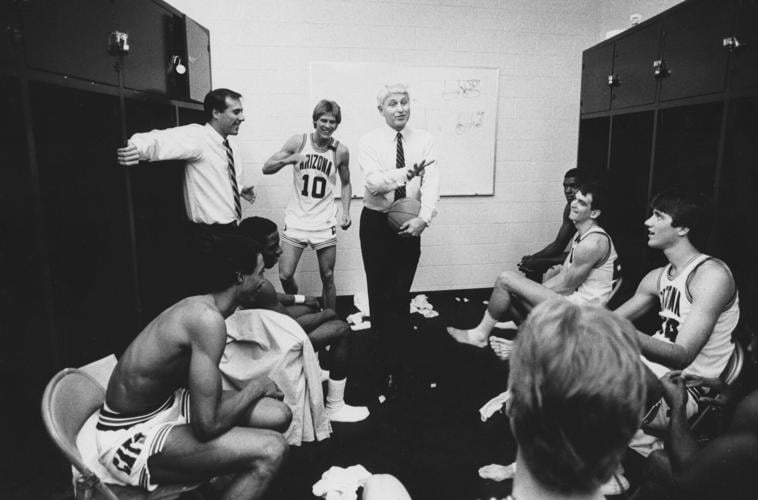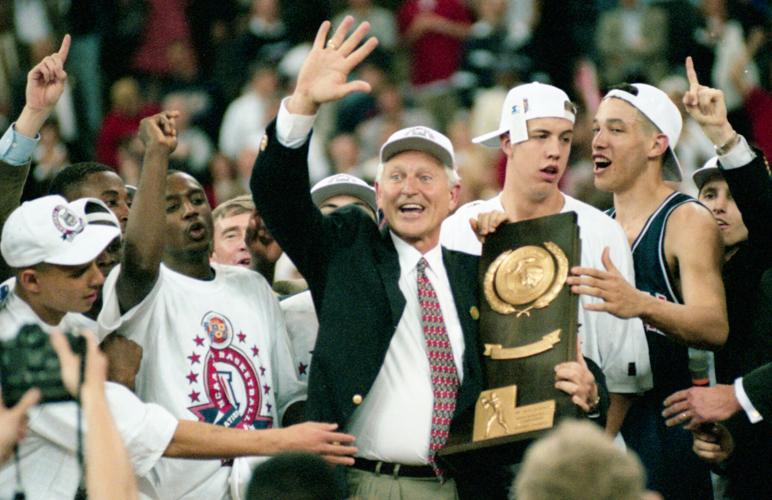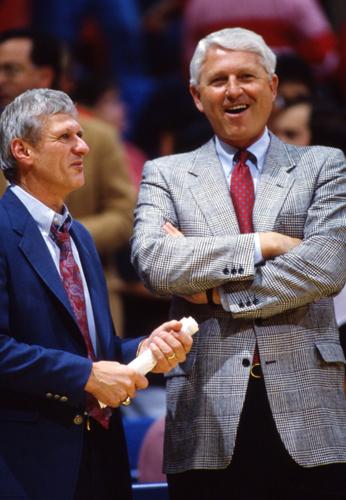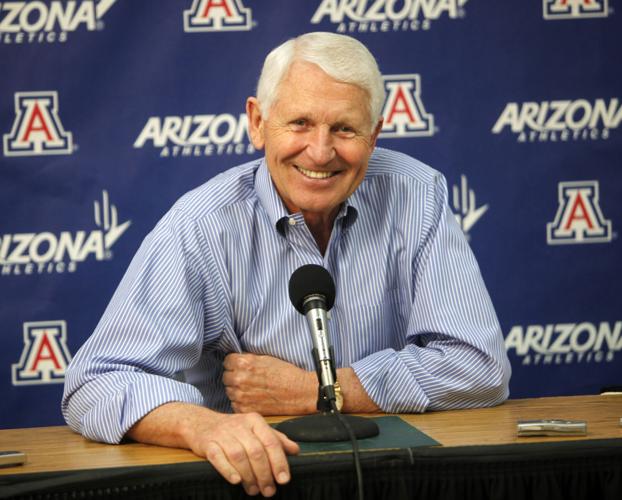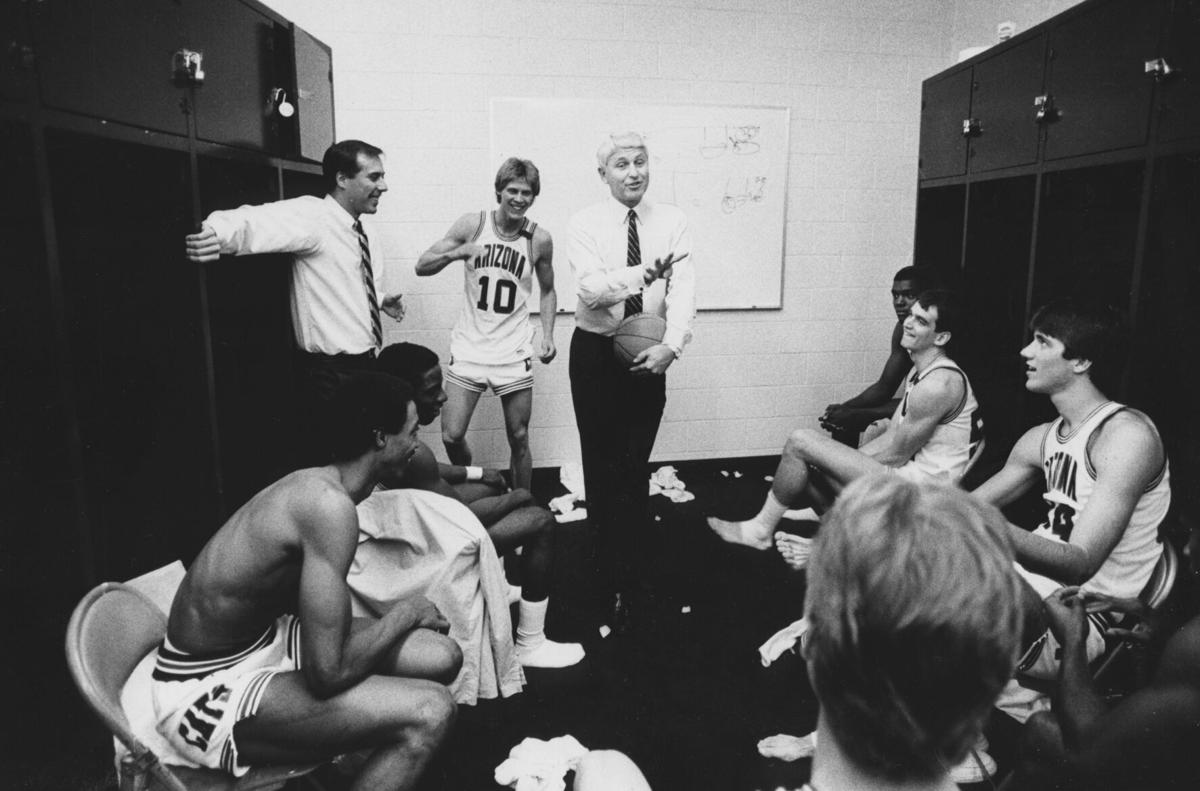Lute Olson signed a 10-year contract with the Iowa Hawkeyes after the 1979 basketball season. He moved his family into a new home at Lake Macbride and a year later coached Iowa to the Final Four.
At 45, Olson was entering the prime of his career, and the University of Iowa was motivated to keep him a Hawkeye for life. After Olson declined a chance to be the coach at USC that spring, Iowa announced plans to build a $23 million basketball arena (about $70 million today).
"This is going to be the best basketball arena in college basketball," Olson told the Iowa City Press-Citizen.
On the night Iowa played its first basketball game at Carver-Hawkeye Arena, Jan. 5, 1983, no one could have had any idea — especially Olson — that within three months he would be the head coach at Arizona, a team that had just finished 4-24.
Olson’s office in the new arena was not yet finished.

Lute Olson talks with wife, Bobbi, before a 1983 press conference in which he would formally become head coach of a University of Arizona team that had just finished 4-24. “The thing I admired about Lute from the beginning was that he had no fear,” said the man who hired him, UA athletic director Cedric Dempsey.
When word leaked that Olson had flown to Tucson with UA athletic director Cedric Dempsey a day after a bitter Sweet 16 loss to Villanova, the reaction was a deep ache.
"My immediate feeling is that Lute is betraying about a million Hawkeye fans who did, and do, idolize him," wrote Press-Citizen columnist Al Grady.
Des Moines Register columnist Maury White was offended. He described Olson’s overnight move to Tucson as "arrogant, pompous and self-omnipitous."
Olson, who is No. 1 on our list of Tucson’s Top 100 Sports Figures of the last 100 years, was not afraid of a challenge or opposition. When he moved from Long Beach State to Iowa in 1973, the Hawkeyes were coming off an 8-16 season, the worst record in school history.
He was entering a league stocked with big-name coaches Bob Knight, Jud Heathcote, Gene Keady and Johnny Orr.
"The thing I admired about Lute from the beginning was that he had no fear," Dempsey told me last summer. "But I still I worried that he would turn me down."

University of Arizona basketball head coach Lute Olson holds the Division I NCAA Championship trophy with his team after they defeated Kentucky in the Final Four in Indianapolis in 1997.
Incredibly, Olson agreed to become Arizona’s coach 24 hours after the private plane he and Dempsey shared from Kansas City touched down at the Tucson airport. It wasn’t that Arizona gave him a financial offer he couldn't refuse. Olson signed a one-year contract for a base salary of $60,000.
"Lute believed in himself," said Dempsey. "I didn’t have any doubt that he would win, but I don’t think anyone could have predicted just how successful he would be."
Olson soon changed the image of the UA athletic department; in his first five seasons, the Wildcats were ranked No. 1, won two Pac-10 championships and reached the Final Four. Little by little, he changed the way Tucsonans viewed themselves. He changed the way those throughout the Pac-10 and in basketball's Top 25 looked at Tucson.
Winners.
It began with Olson’s commanding presence and sideline demeanor — he was 6 feet 4 inches tall and carried himself like a basketball version of John Wayne. Olson had movie-star good looks and a sense of confidence that suggested no challenge was too big.
He scheduled (and beat) Duke, Kansas, North Carolina, Syracuse and Michigan. He dominated the series against UCLA and replaced the Pac-10’s top basketball franchise of the 1980s, Oregon State, beating the Beavers in his first season and then began an 11-game winning streak against the coach who had ruled the league, OSU’s Ralph Miller.
He ruled over Arizona State, sweeping the Sun Devils his first season and beating them 16 times in 17 games.

Arizona State coach Bill Frieder talks with friend Lute Olson, head coach of the University of Arizona, in 1991.
Olson’s national profile became such that he was selected to be head coach of Team USA at the 1986 World Championships, deploying college players such as Navy’s David Robinson, North Carolina’s Kenny Smith and the UA’s Steve Kerr and Sean Elliott to stun the heavily favored pros from the Soviet Union in the gold medal game in Spain.
Olson was in line to be the USA Olympic coach, 1992, but that changed after Georgetown coach John Thompson blew the 1988 Olympics. The United States Olympic Committee then decided to use NBA players.
Kentucky twice offered Olson UK’s head coaching job, in 1985 and 1989, but both times he declined, for many of the same reasons he left Iowa. He and his wife, Bobbi, did not want to return to a fishbowl-type environment in Kentucky.
"You can go into a restaurant in Tucson and enjoy the time with your family," Olson said after turning down Kentucky in 1989. "The quality of life here is what we want."

Arizona basketball coach Lute Olson eschews autograph seekers before the NCAA Final Four semifinal against Oklahoma on April 2, 1988, in Kansas City.
It wasn’t that Olson lived in relative privacy. He was the most recognizable figure in Tucson, and maybe Arizona. He made hundreds of thousands of dollars on TV commercials and endorsements. He was even the grand marshal of the Tucson Rodeo parade.
But mostly, Tucsonans gave him space.
In 1997, I attended a Catalina Foothills High Schools girls basketball game at Sahuaro High School. Olson's granddaughter, Julie Brase, played for the '97 state champion Falcons, becoming the leading scorer in Arizona girls prep history.
Lute and Bobbi sat behind the Foothills bench. Everyone in the gymnasium saw them, but it wasn’t until after the game that a few approached and asked for autographs.
Those who followed UA basketball during Olson’s 25 seasons have many choices as favorite games and enduring memories: the Final Fours; Steve Kerr’s emotional breakout game against ASU; the afternoon Sean Elliott broke the Pac-10 career scoring record; the double-overtime win over Duke; the night Sean Rooks shut down LSU’s Shaquille O’Neill; buzzer beaters against UCLA; upsets over No. 1 Stanford; and the teary night in 2001 when Olson returned to the sidelines following Bobbi’s tragic death.

Former University of Arizona men's basketball coach Lute Olson speaks to the media in an open topic press conference in 2009, after he retired from coaching.
The most indelible memory I have of Olson was the frigid December night, 1987, when No. 4 Arizona played at No. 3 Iowa in the House that Lute Built.
When Olson walked onto the court a few minutes before tipoff, the crowd roared. Half of them booed. The other half chanted "Lute! Lute! Lute!" It was like a heavyweight boxing championship fight. I almost expected Muhammad Ali and Joe Frazier to walk onto the court.
Arizona got in the best punches that night, winning 66-59. Olson beamed.
"Our guys knew I really wanted to win this one," Olson said in a corridor of Carver-Hawkeye Arena. "You don’t spend nine years of your life in a place where you know all these people and have all these great memories without coming back to a special kind of atmosphere."

About midnight, Olson walked into the Highlander Motel a few miles from Carver-Hawkeye Arena. He had spent an hour or two at the home of several close friends from Iowa City, enjoying a special postgame victory toast or two.
"Pretty good night, huh?" I asked as he and Bobbi walked by.
"One of the best," he said.
There would be many more of those.
Lute Olson was head basketball coach at the University of Arizona from 1983-2008. He was a seven-time Pac-10 Coach of the Year, made five Final Four appearances, won the 1997 NCAA Championship and was inducted into the Basketball Hall of Fame in 2002. He died Aug. 27, 2020.
Photos: Arizona Wildcats basketball coach Lute Olson
Lute Olson
Updated
UA basketball head coach Lute Olson and player Sean Elliott during their game against USC in 1989.
Lute Olson
Updated
Lute Olson playing guard in football in 1955.
Lute Olson
Updated
Lute Olson as a junior in high school in 1951.
Lute Olson
Updated
Lute Olson (right) with friend Wes Bodin as they appeared in the Augsburg College school paper on Friday, November 21, 1952, Lute's freshman year at the Minneapolis school where he majored in History.
Lute Olson
Updated
Rookie coach: Lute Olson knew his X's and O's in his first job at Mahnomen High in 1956-57, and, as a yearbook photo suggests, won over players and bosses with his personality.
Lute Olson
Updated
Lute Olson, head coach Marina HS, Huntington Beach, Calif. 1967-68.
Lute Olson
Updated
Lute Olson as head coach of his 1970-71 Long Beach Community College basketball team.
Lute Olson
Updated
Iowa head coach Lute Olson, center, and his assistant coaches leap off the bench in disbelief after the referees failed to call traveling against Villanova during Friday night's NCAA Midwest Regional semifinal game in Kansas City, Mo., on March 25, 1983.
Lute Olson
Updated
Lute Olson talks with wife Bobbi before a press conference in which he will formally become the new head coach of men's basketball at the U of A in 1983.
Lute Olson
Updated
When Olson joined the UA in 1983, he brought with him a commanding presence. "When he walks over to his office with you," one player said, "you feel like you're with the president."
Lute Olson
Updated
Lute Olson talks to his players during practice at McKale Center in 1983.
Lute Olson
Updated
Fans of coach Lute Olson in McKale Center in 1984.
Lute Olson
Updated
Lute Olson (center) coaching his 1984 squad.
Lute Olson
Updated
University of Arizona basketball coach Lute Olson during a press conference in 1985.
Lute Olson
Updated
At the opening gala for Loews Ventana Canyon Resort, on April 27, 1985, Mrs. Bobbi Olson talks with Willard Scott as her husband and University of Arizona basketball coach, Lute Olson, looks on.
Lute Olson
Updated
University of Arizona basketball coach Lute Olson gathers his players together during a time out against Alabama on March 15, 1985.
Lute Olson
Updated
Arizona coach Lute Olson coaching at his youth basketball camp in 1985.
Lute Olson
Updated
Arizona coach Lute Olson at a charity bike event in 1987 with assistant Kevin O'Neill, far left, and player Harvey Mason, far right.
Lute Olson
Updated
Arizona State head coach Bill Frieder, left, and University of Arizona head coach Lute Olson appeared in several funny commercials for Valley National Bank in the mid-1980s.
Lute Olson
Updated
Recovering from knee surgery, Steve Kerr gets a visit from University of Arizona basketball coach Lute Olson and teammate Sean Elliott at the St. Mary's pediatric ward on July 22, 1986 in Tucson. Margo Brennan, who would become his future wife, sits by Kerr's side. Olson awarded Kerr, who was on the USA Basketball team, with the Gold medal from the FIBA World Championship game in Spain where he was injured. Because of the injury Kerr missed the entire 1986-87 season. Photo by Charlie Leight / Arizona Daily Star
Lute Olson
Updated
Arizona head coach Lute Olson donned a cowboy hat for the Tucson Rodeo in 1988.
Arizona vs. Oklahoma / 1988 NCAA Final Four
Updated
Arizona basketball coach Lute Olson during open practice prior to the NCAA Final Four semi-final against Oklahoma on April 2, 1988, in Kansas City, Mo.
Arizona vs. Oklahoma / 1988 NCAA Final Four
Updated
Arizona basketball coach Lute Olson eschews autograph seekers prior to the NCAA Final Four semi-final against Oklahoma on April 2, 1988, in Kansas City, Mo. Olson was 0-3 in the NCAA Tournament in his first four seasons with the Wildcats before the magical 1987-88 run, when UA advanced to its first Final Four.
032522-tuc-spt-elliott-p3
Updated
Coach Lute Olson is beaming while listening to star player Sean Elliott at a rally and parade for the 1988 UA men's basketball team, which made the Final Four.
Lute Olson
Updated
Coach Lute Olson with player Steve Kerr, now the coach of the Golden State Warriors, at a rally and parade for the men's basketball team at University of Arizona stadium in Tucson after the 1988 NCAA Final Four.
Lute Olson
Updated
Arizona Coach Lute Olson in his office in Sept. 1988, with the Pac-10 Trophy (foreground). The team made it into the 1988 NCAA Final Four earlier in the year.
Lute Olson
Updated
A tense Lute Olson watches from the bench during a game in 1989.
Lute Olson
Updated
Arizona head coach Lute Olson reacts to an official's call at McKale in January, 1989.
Lute Olson
Updated
Arizona coach Lute Olson, left, during a tense moment versus Washington State during the Pac-10 Tournament at the Forum in Los Angeles in 1989.
Lute Olson
Updated
Coach Dale Brown of Louisiana State University, chatting with University of Arizona head coach Lute Olson during a basketball game at McKale Center, Tucson, on Dec. 7, 1991.
Lute Olson
Updated
Arizona State coach Bill Frieder chats with friend Lute Olson, head coach of the University of Arizona, in 1991.
Lute Olson, Kenny Lofton
Updated
Former University of Arizona basketball player Kenny Lofton, left, greets coach Lute Olson at a Cleveland Indians baseball spring training game at Hi Corbett Field on March 31, 1992.
1994 Arizona Wildcats Final Four basketball team
Updated
Arizona coach Lute Olson and star point guard Damon Stoudamire embrace during the 1994 NCAA Final Four in Charlotte, N.C.
Lute Olson
Updated
Arizona head coach Lute Olson smiles in front of cheering fans at Arizona Stadium on April 5, 1994, after returning from the Final Four in Charlotte, NC.
Lute Olson
Updated
Matt Brase, then in the seventh grade, celebrates Christmas 1994 with Lute Olson, his grandfather.
Lute Olson
Updated
Michael Dickerson and Lute share a moment near the end of the game against North Carolina in the Final Four in 1997.
Lute Olson
Updated
Lute Olson and the Wildcats celebrate during the end of the second half of their NCAA Final Four Championship game against Kentucky in Indianapolis in 1997.
Lute Olson
Updated
Arizona coach Lute Olson holds up the net for the fans after Arizona beat Kentucky 84-79 in overtime to win the national championship Monday, March 31, 1997, at the NCAA Final Four tournament in Indianapolis.
Lute Olson
Updated
UA head coach Lute Olson hold the Divsion I NCAA Championship trophy with his team from left; Jason Lee, Miles Simon, Jason Terry, Lute, Justin Wessel, and Bennett Davison after they defeated Kentucky in the 1997 Final Four in Indianapolis.
Lute Olson
Updated
Lute Olson and wife, Bobbi Olson wave to fans after the Wildcats won the NCAA National Championship in Indianapolis in 1997.
Lute Olson
Updated
"You could make a fortune!" Jay Leno told Lute Olson during "The Tonight Show", handing him a can of 'Lute Spray." Just say "One spray, and you too can be a wildcat." Olson appeared on the show on April 2, 1997, after the team won the NCAA National Championship.
Lute Olson
Updated
Sakura chef Steve Yim and Wildcat guard Jason Terry watch as UA coach Lute Olson adds egg to fried rice during the Lute Olson Celebrity Chefs benefit in Nov. 1997.
Lute Olson
Updated
In this 1998 photo, Cheryl Bell, Steve Tobias, Patrick Coco, Tom Alexander and Brian Ralston are all sporting the new" Lute lids" a rubbery white hair piece that is suppose to make you look like Lute Olson.
Lute Olson
Updated
Arizona coach Lute Olson, left, his wife Bobbi, former athletic director Cedric Dempsey, AD Jim Livengood and university president Peter Likens during a ceremony at a game at McKale Center on Feb. 26, 2000.
Lute Olson
Updated
UA's head basketball coach Lute Olson and his wife Bobbi share a moment before unveiling the new floor to McKale Center in a post game ceremony in 2000.
Lute Olson
Updated
UA basketball head coach Lute Olson (right) has five talented freshmen for the 2001 season, including Channing Frye, Isaiah Fox, Dennis Latimore, Salim Stoudamire and Will Bynum. Photo by David Sanders.
Lute Olson
Updated
University of Arizona basketball coach Lute Olson waves to the crowd as he is introduced during the midnight madness practice game at the McKale Center on Oct. 12. 2001.
Lute Olson
Updated
UA head coach Lute Olson with legendary UCLA basketball coach John Wooden get ready to present the Wildcats with the Wooden Classic trophy after UA defeated Purdue in 2001.
Lute Olson
Updated
Lute Olson checks on Loren Woods after Woods hurt his ankle during practice in the Alamodome in San Antonio,Texas, during the NCAA Tournament in 2001.
Steve Kerr
Updated
Former University of Arizona stars Steve Kerr (left) and Sean Elliott greet UA coach Lute Olson in March, 2001.
Arizona Wildcats in NCAA Tournament
Updated
Lute Olson reacts during the first half of UA vs. Duke NCAA Championship in Minneapolis, MN, April 2, 2001.
A look back at UA Commencement ceremonies
Updated
University of Arizona head basketball coach Lute Olson, who gave the commencement speech to UA's 124th graduating class May 12, 2001, laughs as he recalls how preparing for this speech was harder than preparing for Illinois, Michigan State, and Duke, all teams that UA had to play against in the this year's Final Four.
Lute Olson
Updated
Members of the Naismith Basketball Hall of Fame, Class of 2002, pose with their Hall of Fame jerseys, from left, Earvin "Magic" Johnson, coaches Lute Olson and Kay Yow, Biserka Petrovic (the mother of the late Drazen Petrovic), coach Larry Brown and Tex Harrison (representing the Harlem Globetrotters) on Wednesday, June 5, 2002, in Los Angeles.
Lute Olson
Updated
Friends and fans in the foreground wait for a memorial service for Lute Olson's wife, Bobbi, at McKale Center in 2001. Bobbi died after a long battle with cancer.
Lute Olson
Updated
University of Arizona basketball coach Lute Olson reacts to a foul called by referee on Channing Frye during the NCAA Tournament on March 22, 2002
Lute Olson
Updated
University of Arizona basketball coach Lute Olson signs autographs at Myers Ganoung Elementary school on May 7, 2002.
Lute Olson
Updated
Lute Olson talks with Channing Frye during a game against sixth-ranked Kansas at Allen Fieldhouse in 2003.
Lute Olson
Updated
UA coach Lute Olson and his assistants rally the Wildcats in their game against Gonzaga during the 2003 NCAA Tournament in Salt Lake City.
Lute Olson
Updated
Photo Illustration of Lute Olson and various stages in his life. Left to right: A junior in high school, playing football and basketball in college, his first coaching job, coaching at California, Iowa, and UA with Sean Elliott, winning the NCAA national title.
Lute Olson
Updated
An agitated Lute Olson stomps partially out onto the court during the run of play after his University of Arizona players failed to score on a possession in the second half against Mississippi State at the Arrowhead Pond in 2004.
Lute Olson
Updated
Lute Olson answers a question during a Hollywood Squares type sketch performed by members of the 1988 basketball team during the All-Star dinner Saturday, Aug. 13 2005, at the Westin La Paloma.
Lute Olson
Updated
UA's Lute Olson doesn't agree with a call in the first half against Memphis during the Chase Fiesta Bowl Classic at McKale on Dec. 20, 2006. UA won 79-71.
Lute Olson
Updated
U of A head coach Lute Olson calls a play from the sidelines in the second half against Oregon at McKale Center in 2007.
Lute Olson
Updated
UA head coach Lute Olson talks with former player Jason Gardner at a party at Lutes house in 2005.
Lute Olson
Updated
Arizona head coach Lute Olson reacts to a foul against the Wildcats during the second half at John Paul Jones Arena in Charlottesville, Virginia in 2006.
Lute Olson
Updated
UA head basketball coach Lute Olson reacts after crossing the finish line with his wife Christine Olson during the Holualoa Tucson Marathon in Dec. 2006.
Lute Olson
Updated
Coach Lute Olson grimaces upon hearing that his University of Arizona team landed a No. 8 seed at the 2007 NCAA Tournament. He was watching the show at the Stadium Club at Arizona Stadium with his wife, Christine.
Lute Olson
Updated
In 2007, Arizona basketball coach Lute Olson took the Wildcats to their 23rd consecutive NCAA tournament, the second-longest streak ever. At Tucson International Airport, Olson headed for a chartered flight Wednesday that took the team to New Orleans for a first-round game against Purdue.
Lute Olson
Updated
A tired Lute Olson talks in April, 2008, about his return to coaching after a leave of absence.
Lute Olson
Updated
Former Arizona men's basketball coach Lute Olson speaks to the media in 2009 during an open topic press conference after stepping down as coach.
Lute Olson
Updated
Former UA basketball coach Lute Olson and daughters Christi Snyder, left, and Vicki Olson, right, laugh as he is honored at Lute and Bobbi Olson Court in McKale Center in 2009.
Lute Olson
Updated
Former University of Arizona Head basketball coach Lute Olson stands with daughters, Vicki Olson, left, and Christi Snyder, right, while they watch a half time celebration to honor Olson at McKale Center in March, 2009.
Lute Olson
Updated
Sean Miller greets Coach Olson in McKale center for the press conference to announce Miller as the new head coach in 2009.
Lute Olson
Updated
Former head coach Lute Olson, Damon Stoudamire and Olson's wife, Kelly Olson joke around following a press conference in 2013 to announce Stoudamire's appointment as an assistant to Sean Miller.
Lute Olson
Updated
Former Arizona head coach Lute Olson greets old friends and checks out the action during an open practice for the second round of the NCAA 2011 Division 1 Men's Basketball Championship at McKale Center in Tucson, Ariz., on March 16, 2011.
Lute Olson
Updated
Lute Olson watches a University of Arizona basketball game in 2013.
Lute Olson
Updated
Jason Terry stands with former head coach Lute Olson as his jersey number is retired during halftime at McKale Center in Tucson on Feb. 19, 2015.
Lute Olson
Updated
Former Arizona head coach Lute Olson and his wife Kelly Pugnea are two red shirts in a sea of yellow in the second half of the Wildcats' game against Cal at Haas Pavilion, Saturday, Jan. 23, 2016, Berkeley, Calif.
Lute Olson statue
Updated
The crowd gathers round to get photos and close look at the new statue of former University of Arizona head coach Lute Olson shortly after its unveiling at the Eddie Lynch Pavilion at McKale Center, Thursday, April 12, 2018, Tucson, Ariz.
Lute Olson statue
Updated
Former University of Arizona basketball coach Lute Olson stands with his wife Kelly shortly after the unveiling of the statue of Olson at the Eddie Lynch Pavilion at McKale Center, Thursday, April 12, 2018, Tucson, Ariz.
Lute Olson statue
Updated
Former University of Arizona basketball coach Lute Olson waves to the crowd while making his entrance a statue in his honor at the Eddie Lynch Pavilion at McKale Center, Thursday, April 12, 2018, Tucson, Ariz.
Lute Olson
Updated
Arizona men's coach Sean Miller, left, chats with former coach Lute Olson at halftime of the women's game against Northern Arizona at McKale Center, Friday, Dec. 21, 2018, Tucson, Ariz.
Lute Olson
Updated
Former Arizona coach head Lute Olson watches the first half of the Wildcats game against Washington at McKale Arena, Thursday, February 7, 2019, Tucson, Ariz.


